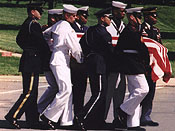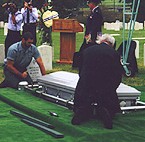Naming the Vietnam Unkown
Identification of the Unknown Soldier
Tri-service honor guard escorts the casket of the Vietnam Unknown Soldier into the Armed Forces Institute of Pathology.
On May 14th, 1998, the Tomb of the Unknowns was opened, and the remains of X-26 were removed from the vault. X-26 was escorted with a tri-service honor guard to the Armed Forces Institute of Pathology where CILHI forensic anthropologists analyzed the remains and took samples of bone to be used for mtDNA testing. The X-26 samples and a second set of bone samples taken from similar skeletal elements were brought to AFDIL for mtDNA sequencing. Each case was analyzed independently, and none of the scientists knew the identity of either case. This type of study is known as a "double blind" study. The mtDNA sequences generated from these two cases were compared to ten reference mtDNA samples from maternal relatives of seven servicemen who were reported missing within a 25 mile radius of the location where the remains of X-26 were found. The mtDNA sequences from the second case did not match any of the reference samples. The results from X-26 excluded six of the families but exactly matched the two samples submitted by Michael Blassie's mother and sister. The mtDNA results established that the remains formerly interred in the Vietnam Tomb of the Unknowns and "known but to God" were Michael Joseph Blassie.
Coming Home
On July 9th, 1998, the remains of First Lt Michael Blassie, escorted by an Air Force honor guard, left the Armed Forces Institute of Pathology and began the journey back home to Missouri. On July 11th, he was buried with full military honors in Jefferson Barracks National Cemetery. Lt Michael Blassie now rests near his hometown, in the same cemetery as his father
Acknowledgements
We would like to extend our thanks to Mitchell Holland, Ph.D., Chief of AFDIL, for his assistance in the research for this exhibit. Special thanks are extended to Patricia Blassie, Jean Blassie, Judy Cozad, and the rest of the Blassie family whose generous loan of objects made this exhibit possible.





